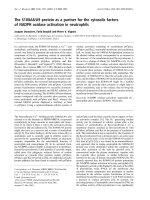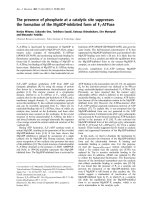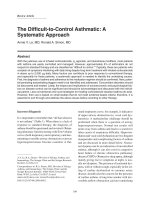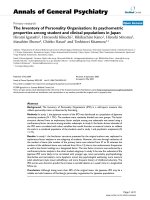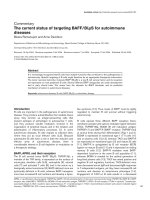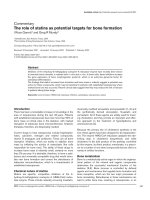Báo cáo y học: "The Mammalian Phenotype Ontology as a tool for annotating, analyzing and comparing phenotypic information" potx
Bạn đang xem bản rút gọn của tài liệu. Xem và tải ngay bản đầy đủ của tài liệu tại đây (901.56 KB, 9 trang )
Genome Biology 2004, 6:R7
comment reviews reports deposited research refereed research interactions information
Open Access
2004Smithet al.Volume 6, Issue 1, Article R7
Method
The Mammalian Phenotype Ontology as a tool for annotating,
analyzing and comparing phenotypic information
Cynthia L Smith
*
, Carroll-Ann W Goldsmith
*†
and Janan T Eppig
*
Addresses:
*
The Jackson Laboratory, 600 Main Street, Bar Harbor, ME 04609, USA.
†
Massachusetts College of Pharmacy and Health Sciences,
School of Pharmacy Manchester, 1260 Elm Street, Manchester, NH 03101, USA.
Correspondence: Janan T Eppig. E-mail:
© 2004 Smith et al.; licensee BioMed Central Ltd.
This is an Open Access article distributed under the terms of the Creative Commons Attribution License (
which permits unrestricted use, distribution, and reproduction in any medium, provided the original work is properly cited.
The Mammalian Phenotype Ontology as a tool for annotating, analyzing and comparing phenotypic information<p>The Mammalian Phenotype (MP) Ontology enables robust annotation of mammalian phenotypes in the context of mutations, quanti-tative trait loci and strains that are used as models of human biology and disease. The MP Ontology supports different levels and richness of phenotypic knowledge and flexible annotations to individual genotypes. It continues to develop dynamically via collaborative input from research groups, mutagenesis consortia, and biological domain experts. The MP Ontology is currently used by the Mouse Genome Database and Rat Genome Database to represent phenotypic data.</p>
Abstract
The Mammalian Phenotype (MP) Ontology enables robust annotation of mammalian phenotypes in
the context of mutations, quantitative trait loci and strains that are used as models of human
biology and disease. The MP Ontology supports different levels and richness of phenotypic
knowledge and flexible annotations to individual genotypes. It continues to develop dynamically via
collaborative input from research groups, mutagenesis consortia, and biological domain experts.
The MP Ontology is currently used by the Mouse Genome Database and Rat Genome Database
to represent phenotypic data.
Background
Mammalian phenotypes are complex and the term itself is
imprecise. Generally, we use the word phenotype in referring
to the appearance or manifestation of a set of traits in an indi-
vidual that result from the combined action and interaction of
genotype and environment.
Because mouse is the premier model organism for the study
of human biology and disease, the goal of comparative pheno-
typing and building new animal models through genetic engi-
neering holds great promise. The mouse has distinct
advantages for studies that translate to humans. It is a small,
short-lived mammal with a fully sequenced genome in which
all life stages can be accessed, and for which myriad tools are
available for precisely experimentally manipulating its
genome. Further, the large collection of inbred strains of mice
and the controlled environment in which the animals live pro-
vides the ability to confirm phenotype observations and to
systematically perturb environmental factors and genetic
input to measure effects under defined conditions. Current
international efforts to 'make a mutation' for every gene
through mutagenesis [1] and genetic engineering [2,3] make
it imperative for phenotype data to be represented in stand-
ard descriptive formats to enable computational analysis and
comparison.
Mammalian phenotypes are frequently genetically complex.
Mutation of even a single gene almost always produces pleio-
tropic effects. Conversely, non-allelic mutations can produce
indistinguishable phenotypes. Modifier genes and epistatic
interactions can markedly alter the phenotype. Combining
different allelic combinations of different genes can produce
unique phenotypes not found in the single-gene mutation
genotype. Imprinting of genes can dramatically affect pheno-
type. Mutations expressed in different inbred strains of mice
can manifest as an increase or decrease of severity or pene-
trance of the corresponding phenotype. Quantitative trait loci
(QTL) can contribute in complex nonlinear ways to the phe-
notype. In addition, mutations that are 'genomic' in nature,
either disrupting or deleting multiple genes or occurring in
intergenic regions, can produce distinct phenotypes and chal-
lenge us to think beyond gene effects to genomic effects. The
Published: 15 December 2004
Genome Biology 2004, 6:R7
Received: 8 September 2004
Revised: 15 November 2004
Accepted: 17 November 2004
The electronic version of this article is the complete one and can be
found online at />R7.2 Genome Biology 2004, Volume 6, Issue 1, Article R7 Smith et al. />Genome Biology 2004, 6:R7
Table 1
Text search for mutations with hair/fur loss defects in the Mouse Locus Catalog
Hairless Nude Bald Hair loss Loss of hair Furloss Loss of fur Composite 'true' result
Al Al
Aldoc*
alp alp
ao ao
Bda Bda Bda
Blai2
†
Bmp6
†
Btk
†
Ctsl Ctsl
dep dep
Dh
†
Dsg3 Dsg3 Dsg3
Ebp Ebp
Eda Eda Eda
Edar Edar
Edaradd Edaradd
exf exf
Fgf7
†
Foxj1*
Foxn1 Foxn1 Foxn1 Foxn1
Frl Frl Frl
hl hl hl
Hoxb8
†
Hr Hr Hr Hr
Htr2b
†
Il7
†
Itgam
†
Itgav
†
jb jb
jd jd jd
Krt2-6g Krt2-6g
ma ma
Ngef
†
Nras
†
Ny Ny Ny Ny
Otc Otc Otc
Pdcd8 Pdcd8
Rbpsuh
‡
Rbpsuh-ps1
‡
Rbpsuh-ps2
‡
Rbpsuh-rs3
‡
Scd1 Scd1
Shc1
†
Genome Biology 2004, Volume 6, Issue 1, Article R7 Smith et al. R7.3
comment reviews reports refereed researchdeposited research interactions information
Genome Biology 2004, 6:R7
outcome of these complex interactions can be dissected and
reproducibly examined by characterizing inbred strains that
represent the combined phenotype of the 'whole-genome'
genotype in its environmental context.
The Mouse Genome Database (MGD) at the Mouse Genome
Informatics website [4,5] serves as the model organism data-
base for mouse, representing the genetics, genomics and biol-
ogy of the mouse and as a community resource for
mammalian studies. Significant reorganization and modeling
of phenotypes is now underway to support these data
robustly, to represent phenotypes in ways that are computa-
tionally accessible, and to provide human interfaces to these
data that will enable knowledge building and hypothesis gen-
eration. One component of this work is the development of
the Mammalian Phenotype (MP) Ontology, a structured
vocabulary that will aid in standardizing annotations and,
with its concepts definitions, unambiguously describe pheno-
typic observations.
Results and discussion
The problems of text
Written descriptions of phenotypes in higher organisms
reflect the complexity of the subject, the richness of language,
and the phenomenal diversity that these data represent.
While text descriptions are commonly used in publications
describing phenotype, and have been the basis of electroni-
cally accessible phenotypic descriptions (for example, Online
Mendelian Inheritance in Man (OMIM) [6] and the Mouse
Locus Catalog (MLC) [7], text is unreliable for searching,
either manually or computationally. From the user's perspec-
tive, even the best full-text search including Boolean opera-
tors will miss appropriate records (false negatives) and return
unwanted records (false positives).
Slc30a4 Slc30a4
St
§
tf tf
Tgfb1
†
Tgfbi
†
Tnfrsf6
†
wal wal
15 18 10 14 2 2 2 27 true results
23 irrelevant
The term heading each column was used to search the Mouse Locus Catalog [7]. The gene symbols listed in the column are those returned in
response to the search. Because this is a text search, any matching text within the written description of the phenotypes for mutants known for that
gene will be counted as a match. The 23 irrelevant results were returned due to: *match based on mapping this gene close to the mutant displaying
this phenotype;
†
experimental result of using mice displaying this phenotype in relation to the gene in question;
‡
match based on gene name, not
phenotype;
§
match based on another mutation which is stated as arising in a stock carrying this phenotype.
Table 1 (Continued)
Text search for mutations with hair/fur loss defects in the Mouse Locus Catalog
Screen shot of the Mammalian Phenotype (MP) Browser in which the term 'lethality-embryonic/perinatal' was selectedFigure 1 (see following page)
Screen shot of the Mammalian Phenotype (MP) Browser in which the term 'lethality-embryonic/perinatal' was selected. At the top (yellow shading) the
term, its synonym and MP unique identifier appear. The number of paths to term (in this case, one) indicates how many paths through the DAG structure
can be traversed to reach the term. The main body of the browser page shows the selected term highlighted and within the context of the hierarchical
path(s) of the MP Ontology. In this example page, three levels of the hierarchy are visible (Phenotype Ontology, its 34 sub-terms, and the two sub-terms
that fall beneath 'lethality-embryonic/perinatal'. The plus sign, appearing for many of the terms on this page, indicates that these terms have additional sub-
terms that can be viewed by clicking on the term to expand the view of that portion of the ontology. The number of genotypes and annotations following
the term 'lethality-embryonic/perinatal' is a hypertext link to those data. This latter feature will be available in early 2005.
R7.4 Genome Biology 2004, Volume 6, Issue 1, Article R7 Smith et al. />Genome Biology 2004, 6:R7
Figure 1 (see legend on previous page)
Genome Biology 2004, Volume 6, Issue 1, Article R7 Smith et al. R7.5
comment reviews reports refereed researchdeposited research interactions information
Genome Biology 2004, 6:R7
Consider the example in Table 1 where searches were done to
find spontaneous mutations in which mice were entirely or
partially devoid of hair/fur. To obtain a complete result, the
user would need to use a number of search terms and syno-
nyms. The wording within the text depends upon the author
of the record and his/her particular word usage and editorial
style. A minimum of four search terms is needed to recover
the 27 relevant mutations displayed in this table and it cannot
be ascertained if this is a complete set of mutations for this
phenotype. Conversely, the user is returned with 23 irrelevant
results. Irrelevant results can be returned for many reasons
including, but not limited to, the following: the author of the
record is contrasting the phenotype of a mutation in one gene
with a mutation in another gene; the author is making a state-
ment that includes the negation of the trait; the match is
based on gene name rather than phenotype; the mutant was
used as a linkage marker to genetically map another gene.
A further detriment to database text records is their difficulty
to update and maintain. As new information is learned about
a phenotypic mutant, the record must be continually rewrit-
ten. Although this practice might be sustained for a small
number of records, it does not scale when thousands of
mutant records are considered. The alternative of simply add-
ing on another paragraph to existing text records becomes
confusing, with potentially conflicting information and differ-
ent writing styles appearing in one textual description, and
unwieldy, with more and more text that may no longer repre-
sent a logical synthesis.
Nomenclatures, vocabularies and ontologies
Formal nomenclatures for genes, mutant alleles and inbred
strains of mice have existed since the 1940s [8,9]. The MGD
[4] serves as the authoritative source for the names and sym-
bols associated with mouse genes, alleles and strains. The
advantage of applying such nomenclatures has been increas-
ingly recognized as genomes become better defined and the
realized power of comparative genomics allows homologous
and orthologous gene relationships to be explicitly defined. At
present, human, mouse and rat gene nomenclatures operate
in parallel, using coordinated symbols for all three species'
genes. In addition, mouse and rat strain nomenclatures were
merged to one standard strain nomenclature recently,
making strain identity and nomenclature conventions con-
sistent. Nomenclature guides for mouse and rat genes,
mutant alleles, and strains are available online and regularly
revised based on international nomenclature committees'
reviews [10].
Beyond nomenclatures, which are key to object identities and
relationships, are vocabularies that can be used to describe
broader concepts and categorizations. Vocabularies can take
many forms, including simple lists of controlled terms, such
as the cytogenetic band designations used to name the bands
defined by chromosome staining or the classes of genetic
markers, such as gene, pseudogene, expressed sequence tag
(EST), and so forth.
The annotation of complex biological data and concepts
requires more than lists and simple vocabularies. Ontologies,
or 'descriptions of what there is', contain both concepts, with
precise meanings, and relationships among those concepts.
As such ontologies are able to support descriptions of com-
plex biology and are useful in making these data more amena-
ble to computational analyses. The first widely used ontology
developed and adopted in the biological domain is the Gene
Table 2
MP Ontology terms and their decomposed forms
MP Ontology term* Object Body location (anatomy/cells) Attribute Modifier Value
Hydrocephaly
†
Cerebrospinal fluid Brain cerebral ventricles Amount Relative Excessive
Brain Size, mass Increased
Trauma Brain Qualitative Observed
Dystrophic cardiac calcinosis
‡
Calcium salts Heart Deposition Observed
Inflammation Heart Qualitative Observed
Lesions Heart Qualitative Artherosclerotic Observed
Lenticonus
§
Eye lens capsule Shape Conical Bulge
Eye cortex Shape Conical Bulge
Osteopetrosis
¶
Trabecular bone Amount Dense Excessive
Cartilage Amount Calcified Excessive
Erythrocytes Relative_number Decreased
Hematopoiesis Location Extramedullary Ectopic
*Definitions from the MP Ontology.
†
Hydrocephaly, excessive accumulation of cerebrospinal fluid in the brain, especially the cerebral ventricles,
often leading to increased brain size and other brain trauma.
‡
Dystrophic cardiac calcinosis, a condition characterized by the localized deposition of
calcium salts in the heart; often occurring in association with inflammation or atherosclerotic lesions and other pathological states.
§
Lenticonus, a
conical bulging of the lens capsule and the underlying cortex of the eye.
¶
Osteopetrosis, excessive formation of dense trabecular bone and excessive
calcified cartilage formation; may lead to anemia and extramedullary hematopoiesis.
R7.6 Genome Biology 2004, Volume 6, Issue 1, Article R7 Smith et al. />Genome Biology 2004, 6:R7
Figure 2 (see legend on next page)
Mice homozygous for this targeted deletion display:
lethality/embryonic-perinatal
embryonic lethality
o generalized developmental arrest after E9.5
o no embryos survived beyond day E11
embryogenesis
neural patterning was normal
delayed/ arrested embryonic development
o
generalized developmental arrest after E9.5
abnormal yolk sac
o embryos retained a primitive yolk sac vascular network
incomplete embryo turning
cardiovascular system
abnormal cardiac development
o cardiac development is normal prior to the development of vascular defects
abnormal vasculature
o abnormal vascular dilation noted at E8.5
o vascular dilation was associated with an increased endothelial proliferation
rate
o in addition to the dilation, narrowing of the rostral dorsal aorta was
observed in E 8.5 embryos
o no difference in vascular apoptosis was observed
abnormal aorta morphology
o dilation occurred throughout the aorta just distal to the heart and extend to
most caudal regions of the E8.5 embryo
abnormal artery morphology
o the intersomitic arteries of the embryo also enlarge in E8.5-E9.0 embryos
o no enlargement of adjacent cardinal veins and no evidence of ateriovenus
shunts
o loss of alpha-Sma staining in arteries of these mice indicates a failure to
recruit arterial smooth muscle cells
abnormal branchial arch artery morphology
o narrowing of the branchial arteries was observed in E8.5 embryos
Relationship to Human Genes and Disease
Phenotypic Similarity to Human Syndrome in Orthologous Human Gene:
CEREBRAL CAVERNOUS MALFORMATIONS OMIM
Genome Biology 2004, Volume 6, Issue 1, Article R7 Smith et al. R7.7
comment reviews reports refereed researchdeposited research interactions information
Genome Biology 2004, 6:R7
Ontology (GO) [11-13] which contains concepts of molecular
function, cellular localization and biological process for anno-
tating the functional aspects of genes. The GO is structured as
a directed acyclic graph (DAG), where each vocabulary term
(node) may have both multiple parent term and multiple
child term relationships. MGD uses GO extensively for gene
annotation [14]. In addition, MGD has adopted the Mouse
Embryo Anatomy Nomenclature Database [15] and the Ana-
tomical Dictionary for the Adult Mouse [16] for annotating
data that include anatomical attributes, such as tissue sources
for clones and phenotypes. The Gene Expression Database
(GXD) [17], integrated with MGD through the Mouse
Genome Informatics (MGI) system [4], applies these anatom-
ical ontologies as a central concept in the description of
expression data.
Mammalian Phenotype Ontology
Although the need for vocabularies as key components to con-
sistent phenotype annotations for mammals has been recog-
nized for some time [18], and many smaller controlled
vocabularies have been implemented to describe various
aspects of phenotype in MGD (for example, class of mutation,
embryonic stem (ES) cell lines used for generating targeted
mutations, type of inheritance), much of the data has
remained in text form. Over the past two years, the Mamma-
lian Phenotype (MP) Ontology has emerged to more precisely
describe phenotypes, and to allow easier access to phenotype-
sequence interactions.
Our goal is to describe the richness of phenotypes as precisely
as they are known, recognizing that phenotype data are by
nature complex and usually incomplete. Taking advantage of
structural properties of a DAG, we have the ability to annotate
phenotypes to the level of data resolution available, whether
general or very specific and the ability to query with a high-
level term, returning all phenotypes containing annotations
to that term or to terms more specific than the query term.
Thus, one can query for 'respiratory signs/symptoms' and
retrieve all phenotypes annotated to this term and its hierar-
chical 'children' (abnormal breathing, abnormal respiratory
sounds, anoxia, apnea, dyspnea, hypercapnia, and so on), or
specifically request annotations to any of these sub-terms.
The top level terms of the MP Ontology include physiological
systems, behavior, developmental phenotypes and survival/
aging. Physiological systems branch into morphological and
physiological phenotypes at the level immediately below. A
browser to view the ontology is available at [19] (Figure 1). In
this browser the DAG structure is flattened into a hierarchy,
with multiple hierarchies representing unique paths to a term
displayed sequentially. MP terms and synonyms can be
searched or users can browse the ontology starting from the
high-level terms and open levels continuously to increasingly
granular terms.
Each MP ontology term has a unique identifier, a definition
and synonyms. In the term detail pages, these data and the
number of hierarchical paths of the vocabulary where the
terms appear are displayed. A plus sign following the term
indicates that children of this term exist. In this figure, dis-
played next to the term, is a link indicating the number of
annotation instances in MGD using this term or children of
this term. This feature, due to be publicly available in early
2005, will greatly improve phenotype-centric searching in
MGD.
Developing the MP vocabulary
To initiate the vocabulary, we first developed a high-level cat-
egorization of phenotypes consisting of approximately 100
terms, such as heart/cardiovascular dysmorphology and skel-
etal axial defects. As we used this list for annotations, terms
were refined and general organizing principles for the MP
vocabulary were developed.
An important component of our approach has been to
address two practical implementation questions. From the
biologist's perspective, the question is what term would be
used to describe a specific phenotypic trait. From the curation
perspective, we ask what terms reflect biological reality and
maximize curator productivity.
From a purely ontological perspective, every trait could be
broken down into a core object, such as 'cornea' or 'gastrula-
tion', defined by anatomical, behavioral or physiological
terms, and a series of attribute vocabularies that describe the
quality, quantity and character of a trait. For the practical rea-
son of needing robust terms to describe phenotypes up-front
to speed curation and the problem of losing biological mean-
ing, particularly for clinical or dysmorphology terms, when
terms are completely deconstructed (that is, the sum of the
parts is less than the term itself), we have chosen to use com-
pound terms in the MP Ontology. A few examples of terms
where it is difficult to preserve the full biological meaning
once they are deconstructed are shown in Table 2. In addi-
tion, it should be noted that each of these terms requires mul-
tiple annotations to recover all aspects that the single term
Example showing a portion of the MGI web display of the phenotype annotations for homozygotes for the Ccm1
tm1Dmar
genetically engineered allele (the first targeted mutation from the Douglas Marchuk laboratory in the cerebral cavernous malformations 1 gene)Figure 2 (see previous page)
Example showing a portion of the MGI web display of the phenotype annotations for homozygotes for the Ccm1
tm1Dmar
genetically engineered allele (the
first targeted mutation from the Douglas Marchuk laboratory in the cerebral cavernous malformations 1 gene). Homozygotes are embryonic lethal,
showing developmental and cardiac abnormalities. Note the organization of annotations under the high level phenotype categories and the link to OMIM
where the mouse and human show similar phenotypic characteristics. See [30] to view the complete record for the Ccm1
tm1Dmar
phenotypic allele.
Searches for phenotypes at MGI can be done via the Alleles and Phenotypes Query Form [31].
R7.8 Genome Biology 2004, Volume 6, Issue 1, Article R7 Smith et al. />Genome Biology 2004, 6:R7
provides. Use of complex terms in the MP Ontology, however,
does not preclude also storing the decomposed version
should this later prove desirable (see PATO model discussed
in [20]). More important, the MP Ontology can currently
hold, for each term, database cross-references to other ontol-
ogies. This is a common practice in GO when compound
terms are developed. For the MP Ontology, these cross-refer-
ences include anatomical terms from the Mouse Anatomy
ontologies [15,16] and the GO process terms [21].
Three major strategies are being pursued to further develop
the vocabulary itself. First and most important is through the
ongoing process of curating phenotype data. As new pheno-
typic traits are described and published, the need for new
terms is recognized. New terms added in this way may be a
simple addition to an existing hierarchical path or may result
in the addition of entire new branches in the hierarchy. Sec-
ond, collaborative efforts between the MGD phenotype cura-
tors, the mouse mutagenesis centers and the rat genetics
community identify new specific terms and suggest improved
organization of terms within particular hierarchical branches.
Third, we are recruiting individuals with expertise in specific
biological domains to review and evaluate sections of the
vocabulary for accuracy, completeness and systematic
arrangement. The MP Ontology is a work in progress and
remains incomplete in some areas. We welcome the partici-
pation of the mammalian research community so that the
most useful, definitive and universally applicable terms will
be included. Information can be obtained by sending e-mail
to
While common pathological and clinical terms are used in the
MP Ontology, considerations for term placement within the
structure and for precise terminology is often derived from
comparison with other open biological ontologies (OBO)
[22]. Recently, a cell-type ontology has become available [23]
and a comparison of terminology to this ontology has not yet
been completed. We are working with the mutant mouse
pathology database Pathbase [24,25] to map and cross-refer-
ence terms from their Pathology Ontology.
Vocabulary tools
The MP Ontology was built as a DAG using the DAG-Edit soft-
ware written by John Richter and Suzanna Lewis [26]. The
MP Ontology is updated daily and can be browsed or searched
online at [19]. MP files also are available in flat file format and
OBO format from our ftp site [27] and are posted at the OBO
site [28].
Phenotype data annotation
Phenotypes are described in the MGD relative to the genotype
of the individual. Genotype objects specifically consist of one
or more allele pairs describing mutations or QTLs and the
genetic background strain(s) where the phenotype was
observed. Each phenotype annotation associates a MP Ontol-
ogy term with a genotype/strain and the reference or data
source supporting this assertion. Additional modifying text
may be annotated to describe detail that is not easily stand-
ardized. Examples include experimental conditions, age of
onset and incidence, and trait penetrance, among others. The
annotation note may also include specifics of the phenotype
where such details are deemed to be too case specific to be a
MP term. In addition, genotypes are associated with OMIM
where a particular mouse genotype is a model for human dis-
eases and syndromes. Figure 2 shows the portion of one phe-
notype record that uses the MP Ontology.
Conclusions
The MP Ontology and annotation schema was designed to
minimize curatorial time, yet remain precise enough to
describe phenotypic data. It supports robust phenotypic
annotations and querying capabilities for mouse phenotype
data. While this vocabulary is far from complete, we have
designed strategies for its continued development as a collab-
orative effort for supporting the representation of existing
mutations and those that continue to be created.
As of 1 November 2004, over 11,150 phenotypic alleles repre-
senting mutations in 5,214 unique genes had been catalogued
in MGD. For these alleles, 9,696 genotype records exist, with
21,556 phenotypic annotation instances. The MP Ontology is
also used in phenotypic data annotations at the RGD [29]. As
our database groups continue to accumulate annotations, it
will be possible to mine these data to ask interesting ques-
tions about similarities and differences in comparable allele
effects between the species, as well as within species. Com-
parative phenotype data will potentially uncover new modi-
fier effects and point to new pathway relationships and
genetic networks tied to disease processes. The MP Ontology
will be critical for enabling computational analyses and pro-
viding a framework for improved web views and other
human-comprehensible displays for the research community.
Acknowledgements
We thank Martin Ringwald and Susan Bello for helpful comments on the
manuscript, and acknowledge members of the MGI and RGD teams, Neu-
romice consortium and Richard S. Smith for contributions to the MP
Ontology development.
References
1. Nadeau JH, Balling R, Barsh G, Beier D, Brown SD, Bucan M, Camper
S, Carlson G, Copeland N, Eppig J, et al.: Sequence interpretation.
Functional annotation of mouse genome sequences. Science
2001, 291:1251-1255.
2. Austin CP, Battey JF, Bradley A, Bucan M, Capecchi M, Collins FS,
Dove WF, Duyk G, Dymecki S, Eppig JT, et al.: The knockout
mouse project. Nat Genet 2004, 36:921-924.
3. Auwerx J, Avner P, Baldock R, Ballabio A, Balling R, Barbacid M, Berns
A, Bradley A, Brown S, Carmeliet P, et al.: The European dimen-
sion for the mouse genome mutagenesis program. Nat Genet
2004, 36:925-927.
4. MGI_3.01 - Mouse Genome Informatics [ormat
ics.jax.org]
5. Bult CJ, Blake JA, Richardson JE, Kadin JA, Eppig JT, Baldarelli RM, Bar-
Genome Biology 2004, Volume 6, Issue 1, Article R7 Smith et al. R7.9
comment reviews reports refereed researchdeposited research interactions information
Genome Biology 2004, 6:R7
santi K, Baya M, Beal JS, Boddy WJ, et al.: The Mouse Genome
Database (MGD): integrating biology with the genome.
Nucleic Acids Res 2004, 32 (Database issue):D476-D481.
6. Online Mendelian Inheritance in Man (OMIM) [http://
www.ncbi.nlm.nih.gov/entrez/query.fcgi?db=OMIM]
7. Mouse Locus Catalog (MLC) [ />searches/noforms_mlc_omim.cgi]
8. Dunn LC, Gruneberg H, Snell GD: Report of the committee on
mouse genetics nomenclature. J Hered 1940, 31:505-506.
9. Snell GD: Biology of the Laboratory Mouse 1st edition. New York:
McGraw-Hill; 1941.
10. Mouse Nomenclature Home page [ormat
ics.jax.org/nomen]
11. Gene Ontology Consortium []
12. Ashburner M, Ball CA, Blake JA, Botstein D, Butler H, Cherry JM,
Davis AP, Dolinski K, Dwight SS, Eppig JT, et al.: Gene Ontology:
tool for the unification of biology. The Gene Ontology
Consortium. Nat Genet 2000, 25:25-29.
13. Gene Ontology Consortium: Creating the gene ontology
resource: design and implementation. Genome Res 2001,
11:1425-1433.
14. Hill DP, Davis AP, Richardson JE, Corradi JP, Ringwald M, Eppig JT,
Blake JA: Strategies for biological annotation of mammalian
systems: implementing gene ontologies in mouse genome
informatics. Genomics 2001, 74:121-128.
15. Bard JL, Kaufman MH, Dubreuil C, Brune RM, Burger A, Baldock RA,
Davidson DR: An internet-accessible database of mouse devel-
opmental anatomy based on a systematic nomenclature.
Mech Dev 1998, 74:111-120.
16. Hayamizu TF, Magan M, Corradi JP, Kadin JA, Ringwald M: The Ana-
tomical Dictionary for the Adult Mouse: a tool for annotat-
ing and integrating data. Genome Biol in press.
17. Hill DP, Begley DA, Finger JH, Hayamizu TF, McCright IJ, Smith CM,
Beal JS, Corbani LE, Blake JA, Eppig JT, et al.: The mouse Gene
Expression Database (GXD): updates and enhancements.
Nucleic Acids Res 2004, 32 (Database issue):D568-D571.
18. Eppig JT: Algorithms for mutant sorting: the need for pheno-
type vocabularies. Mamm Genome 2000, 11:584-589.
19. Mammalian Phenotype Ontology Search [or
matics.jax.org/searches/MP_form.shtml]
20. Gkoutos GV, Green ECJ, Hancock JM, Davidson D: Using ontolo-
gies to describe mouse phenotypes. Genome Biol 2004, 6:R8.
21. Gene Ontology Consortium: The Gene Ontology (GO) data-
base and informatics resource. Nucleic Acids Res 2004, 32(data-
base):D258-D261.
22. Open biological ontologies (OBO) []
23. Bard JL, Ashburner M: A Structured Controlled Vocabulary of Cell Types .
/>24. Pathbase []
25. Schofield PN, Bard JB, Booth C, Boniver J, Covelli V, Delvenne P,
Ellender M, Engstrom W, Goessner W, Gruenberger M, et al.: Path-
base: a database of mutant mouse pathology. Nucleic Acids Res
2004, 32 (Database issue):D512-D515.
26. DAG-Edit [ />GO.tools.html#dagedit]
27. Mammalian Phenotype Ontology ftp site [ormat
ics.jax.org/pub/reports/index.html#pheno]
28. Mammalian Phenotype Ontology posted at the OBO site
[ />29. Rat Genome Database (RGD) []
30. MGI record for the Ccm1
tm1Dmar
phenotypic allele [http://
www.informatics.jax.org/searches/allele.cgi?22569]
31. MGI Alleles and Phenotypes Query Form [or
matics.jax.org/searches/allele_form.shtml]

